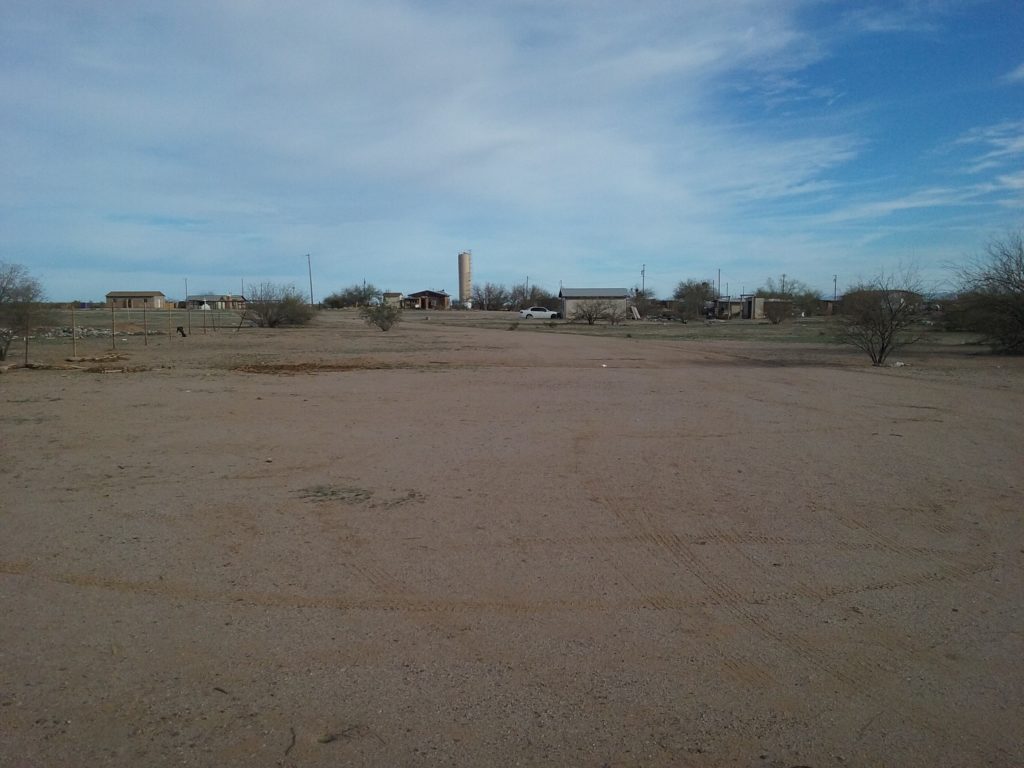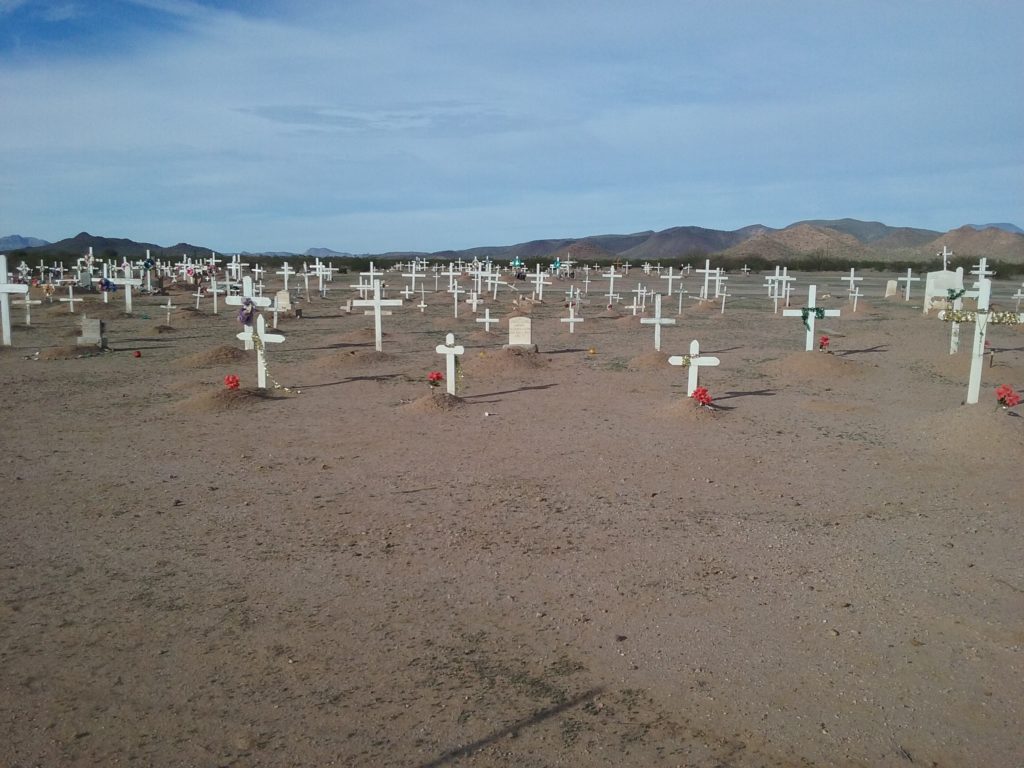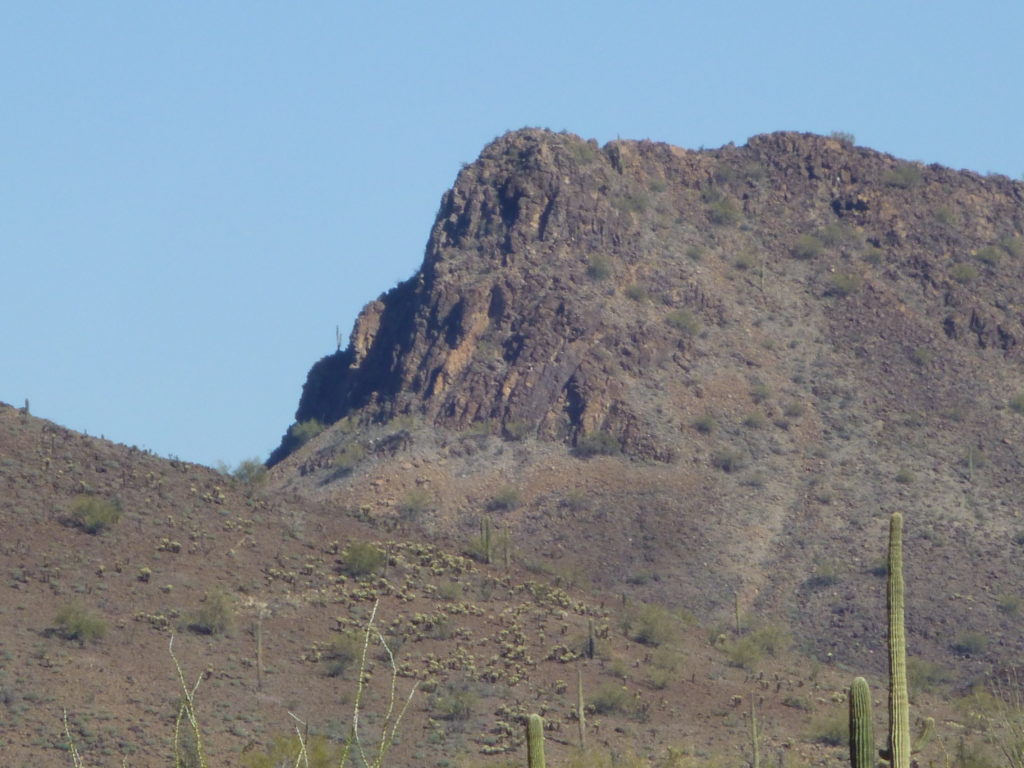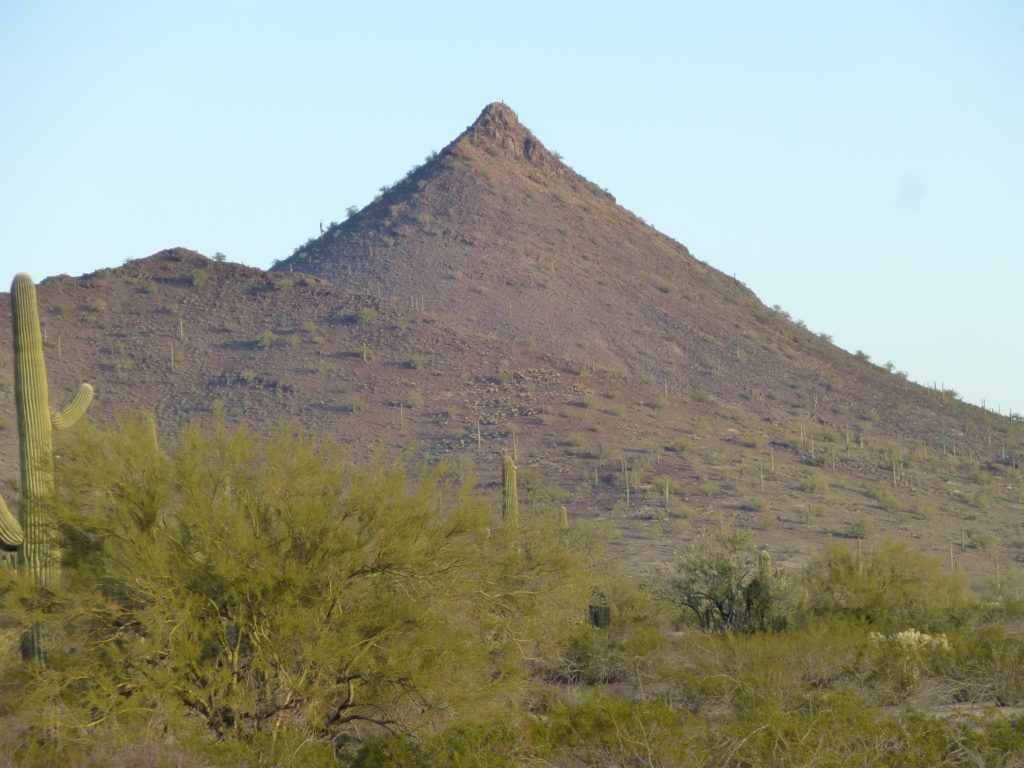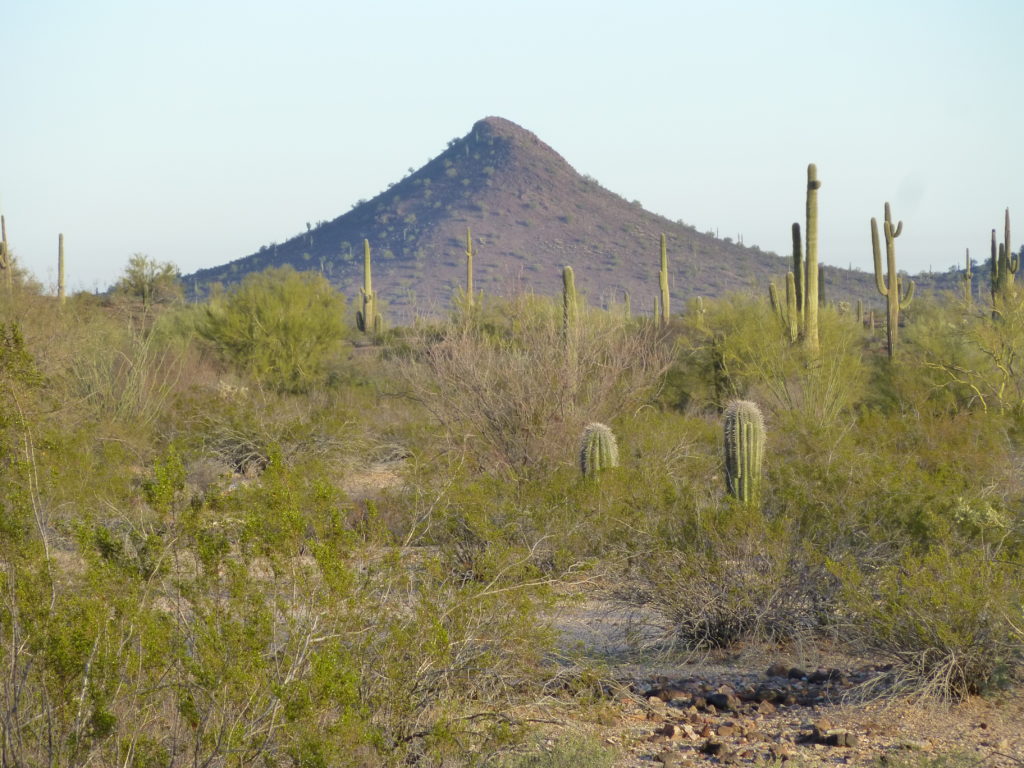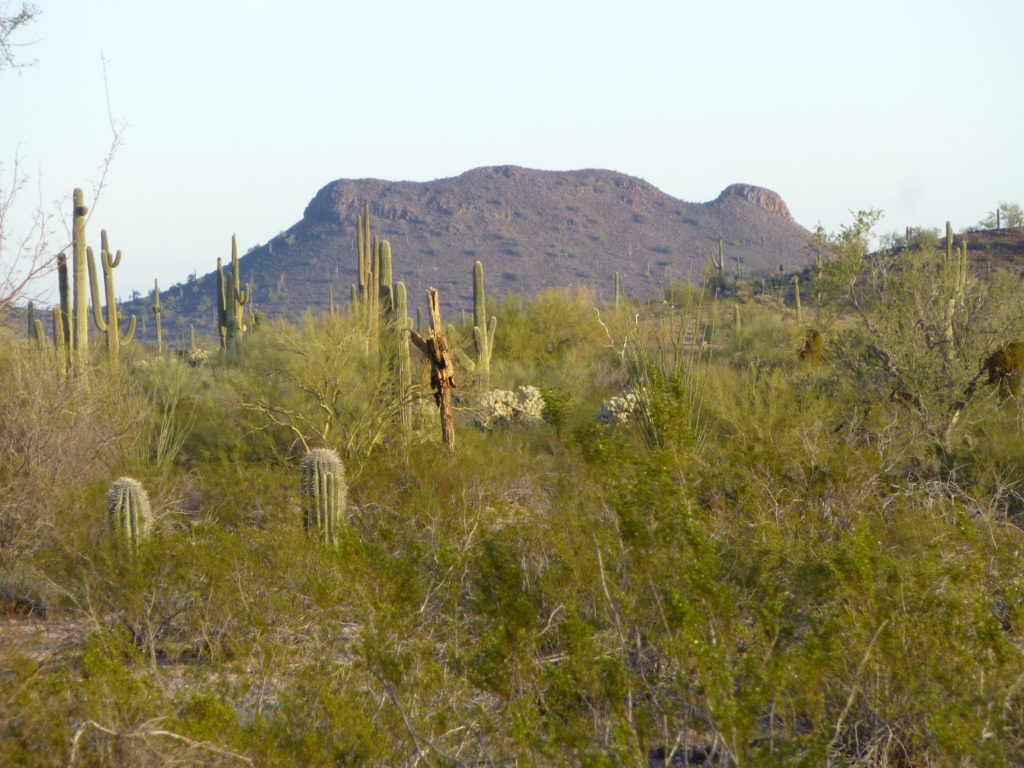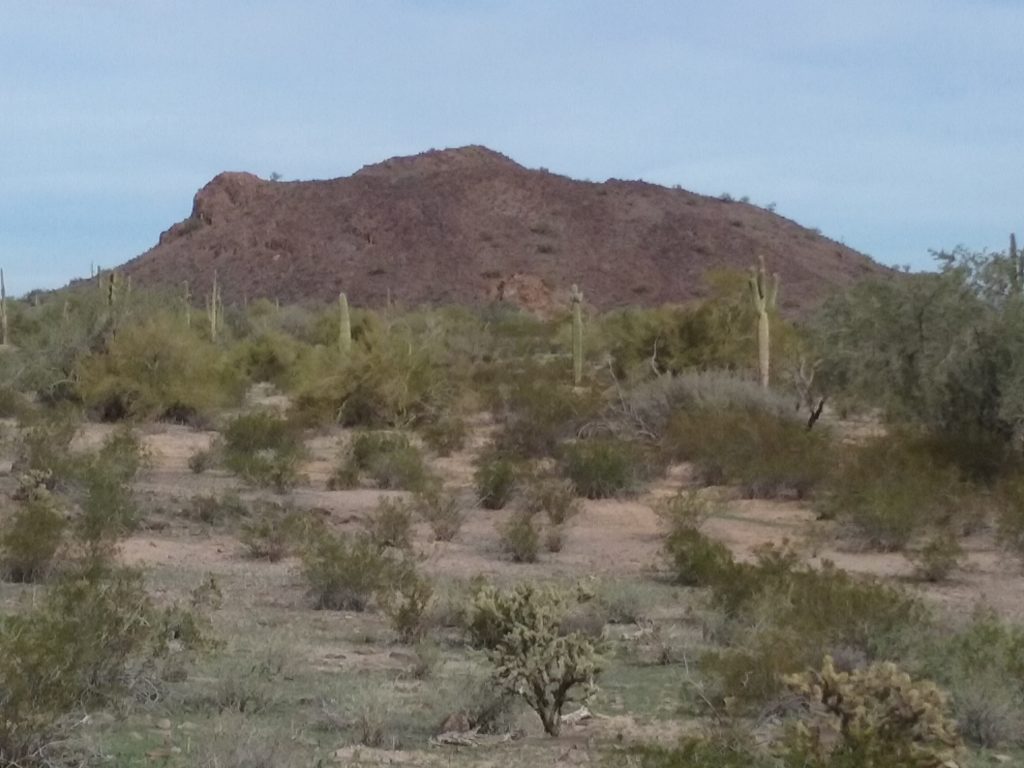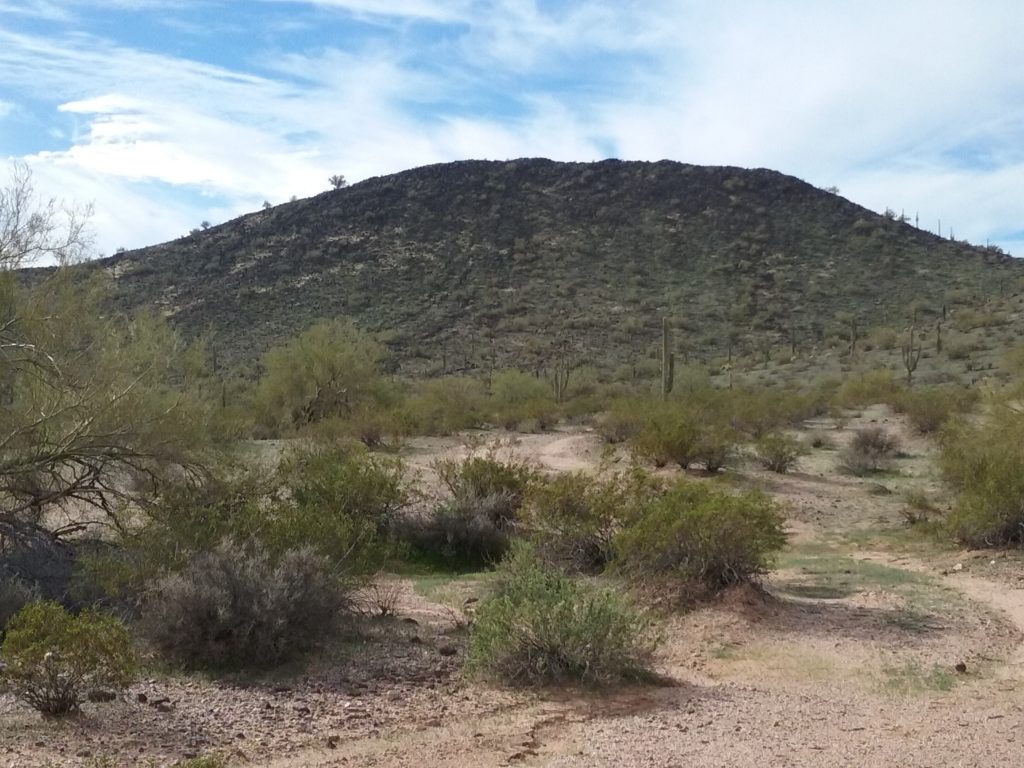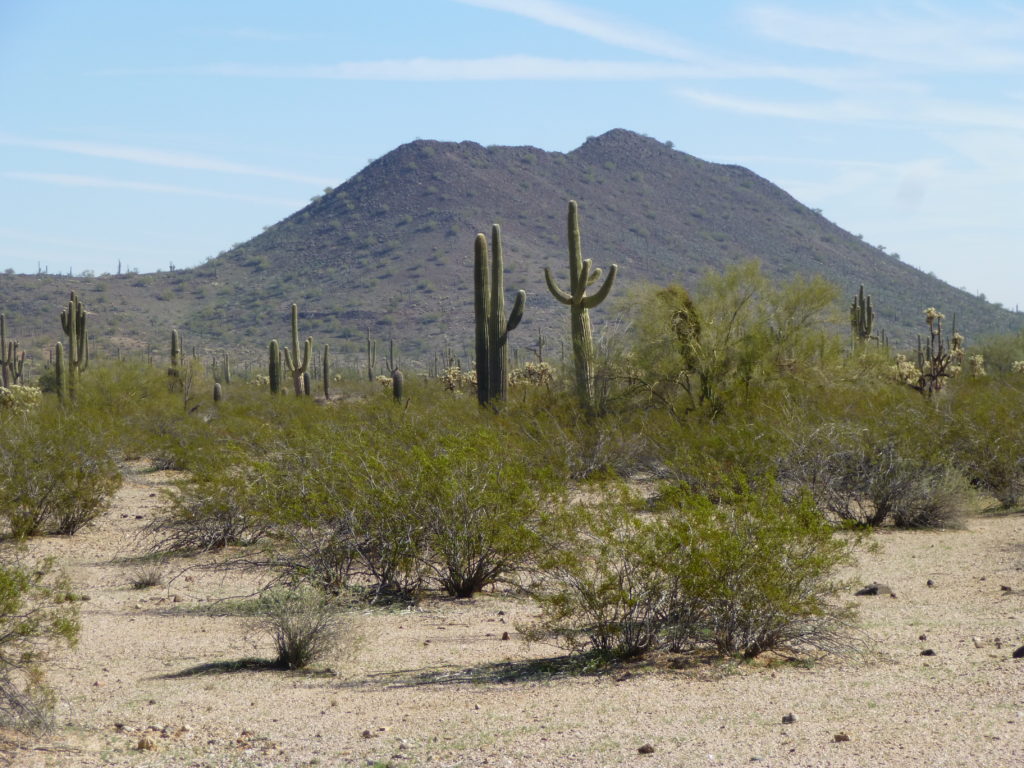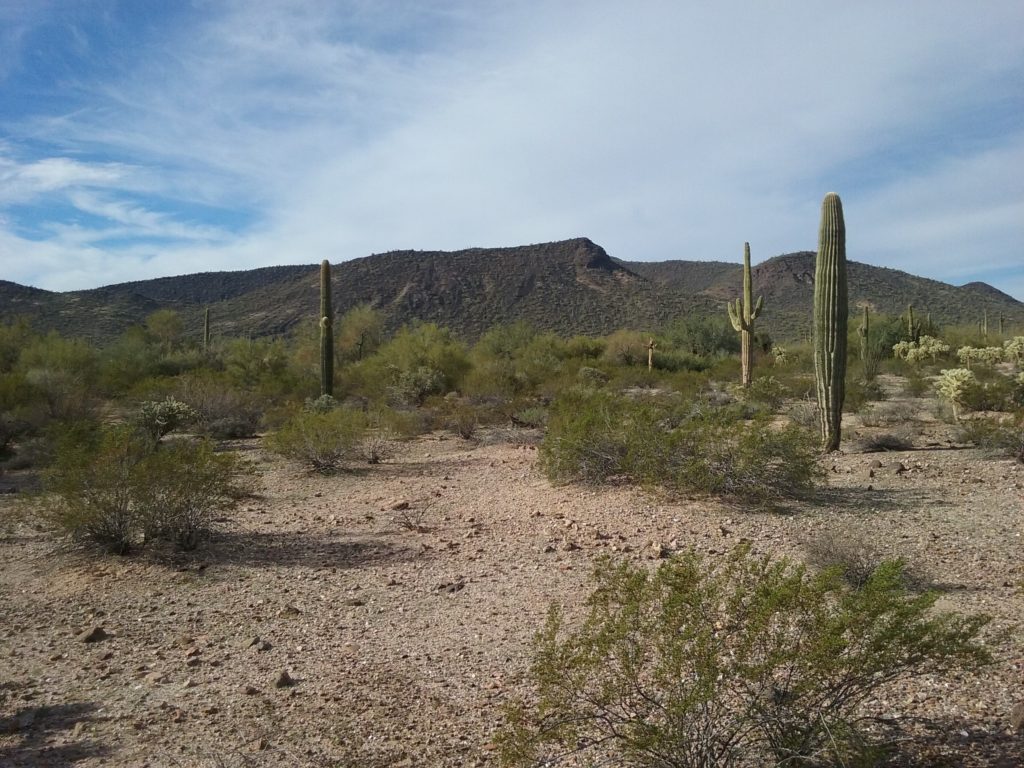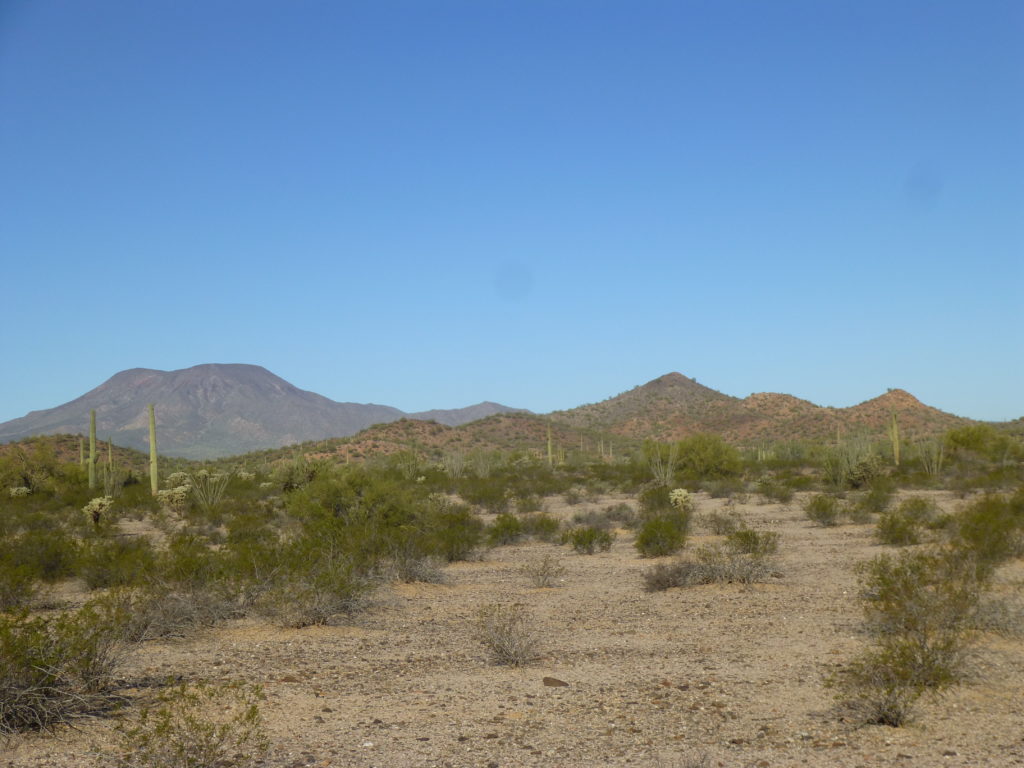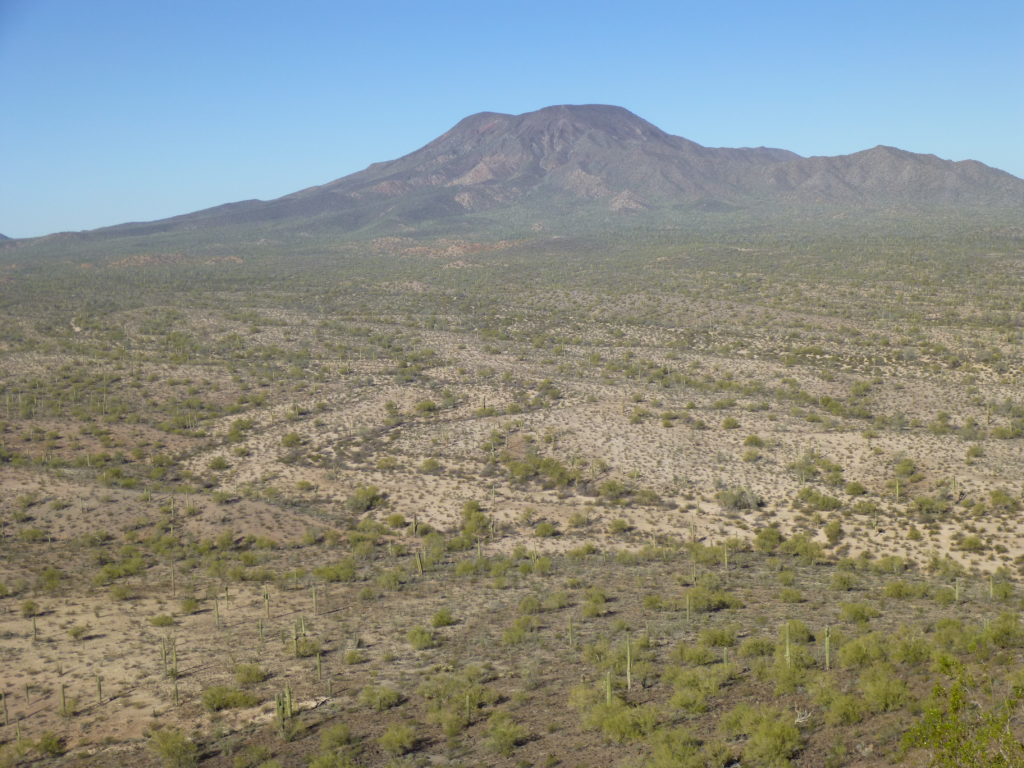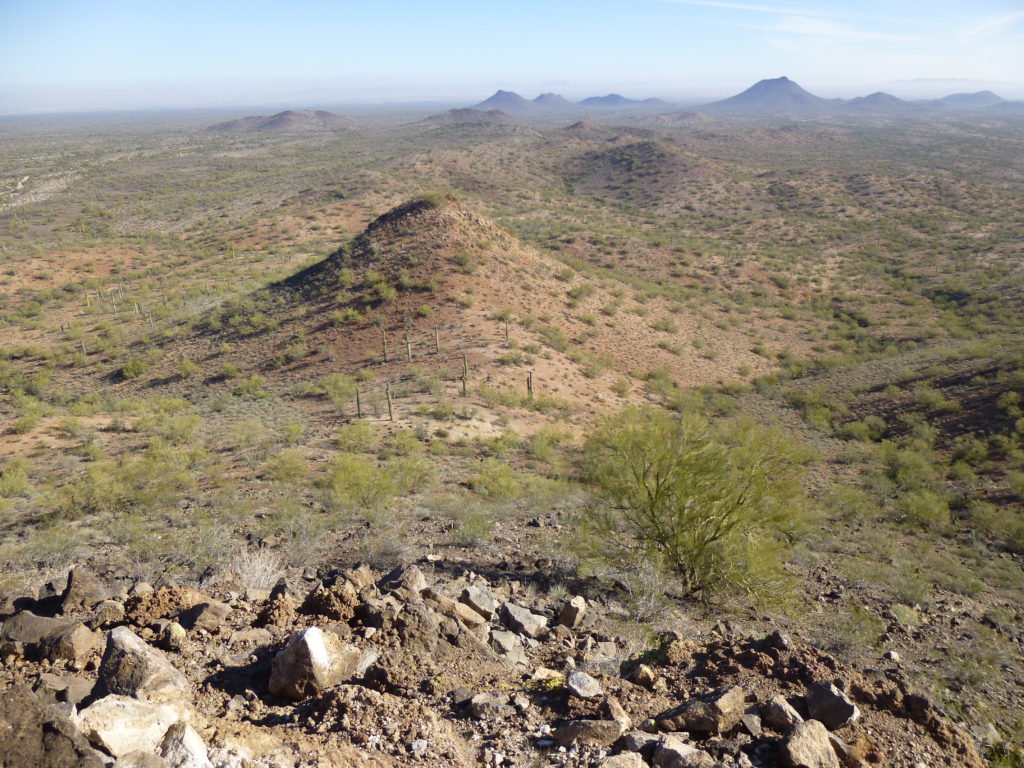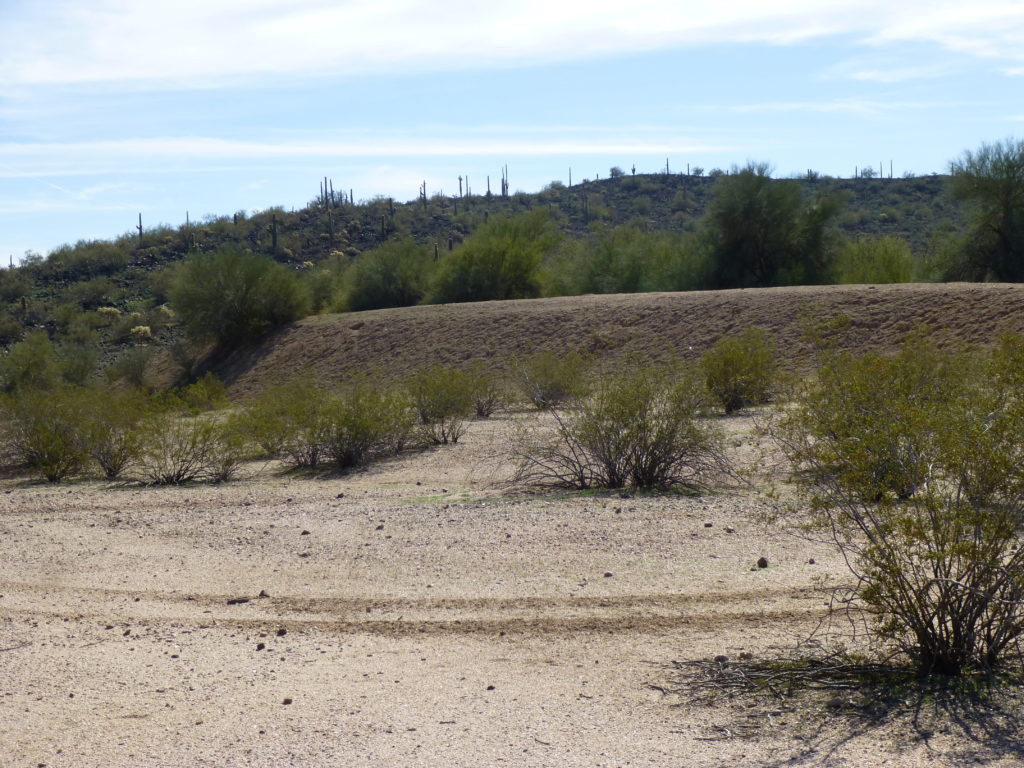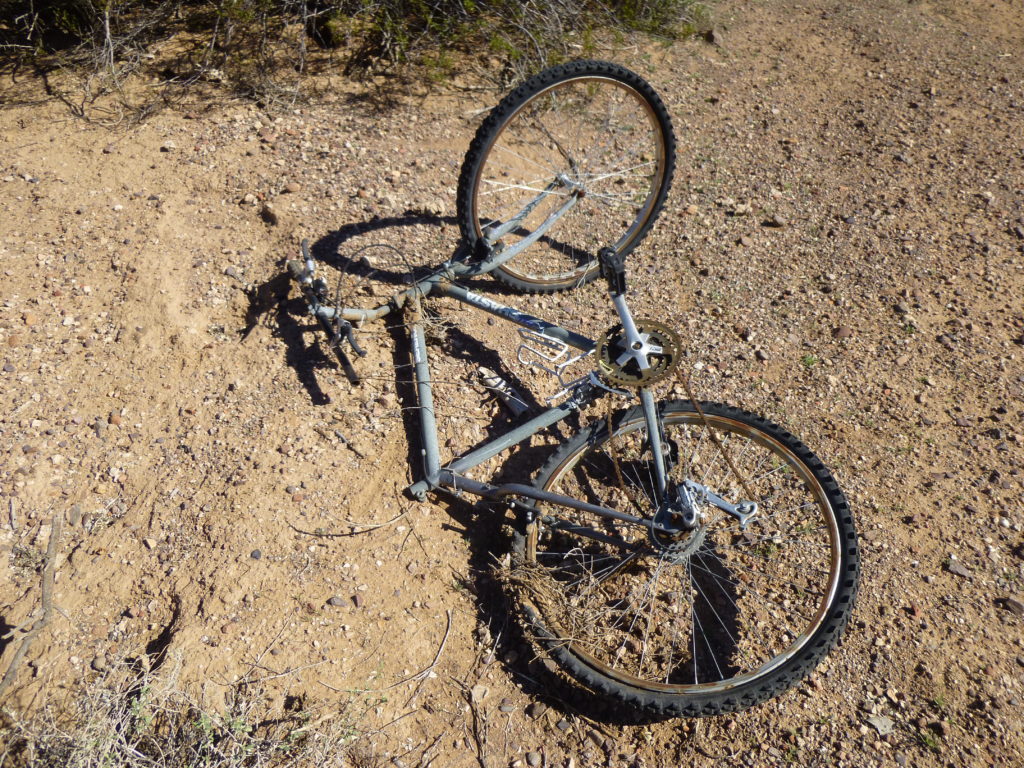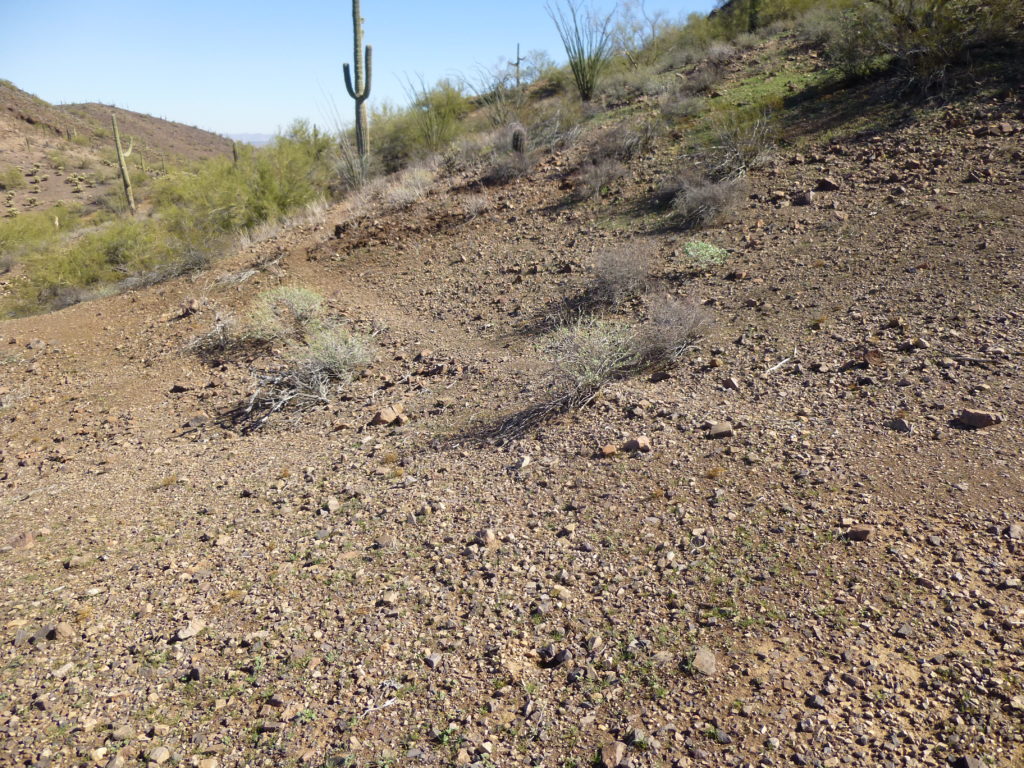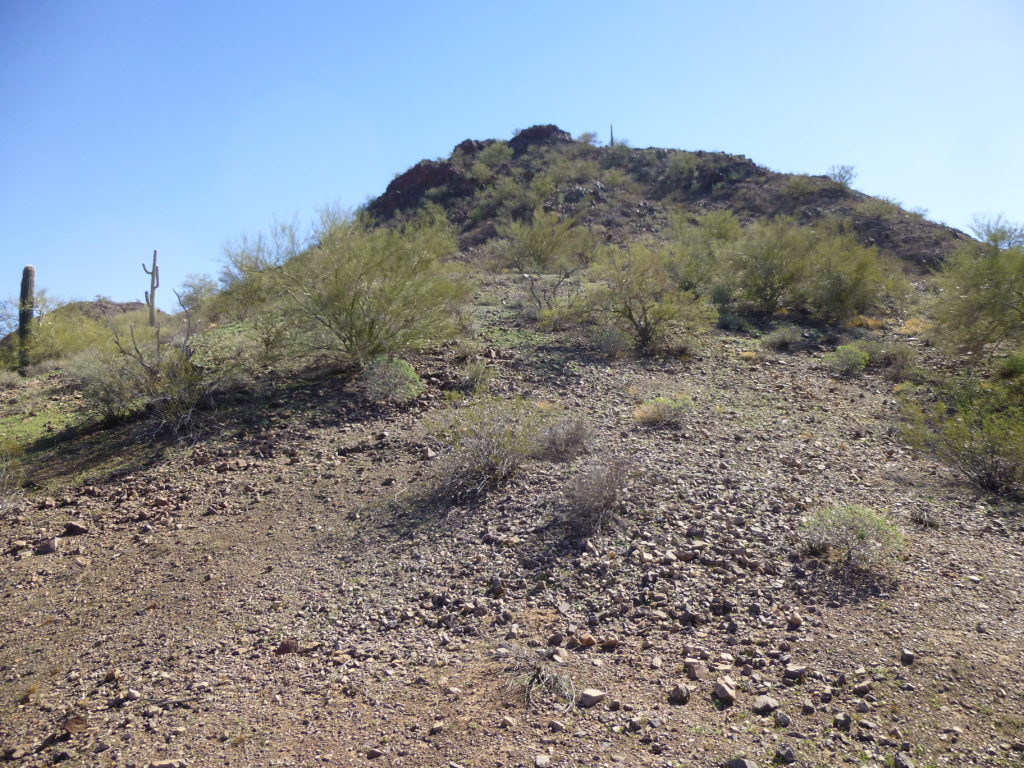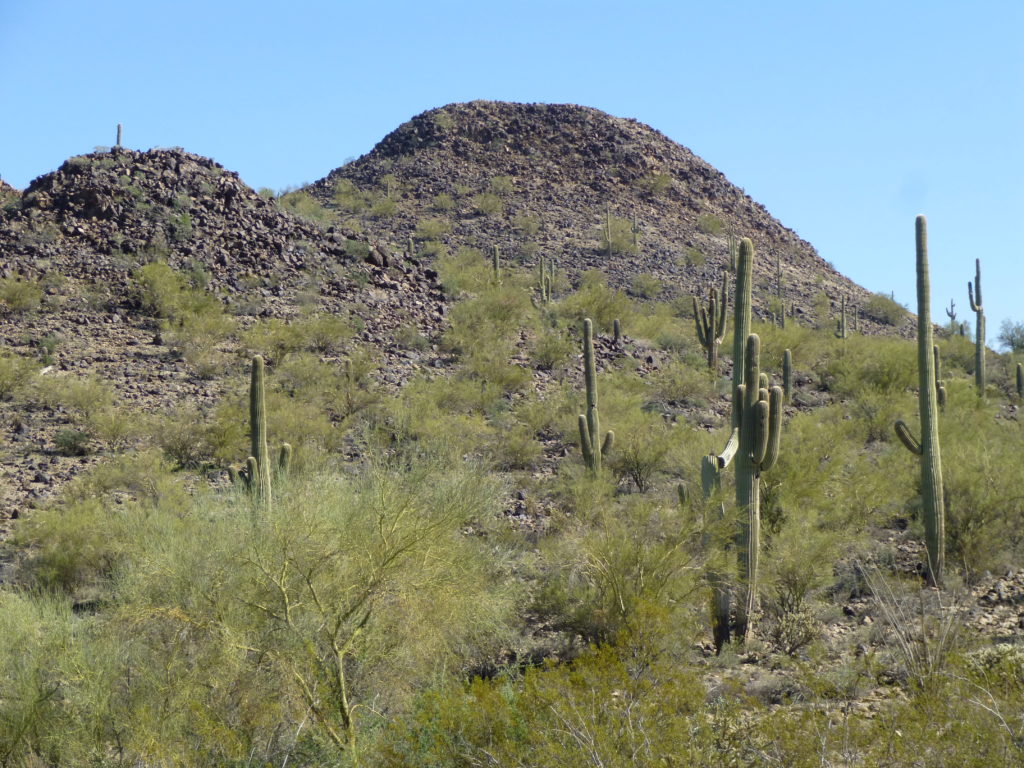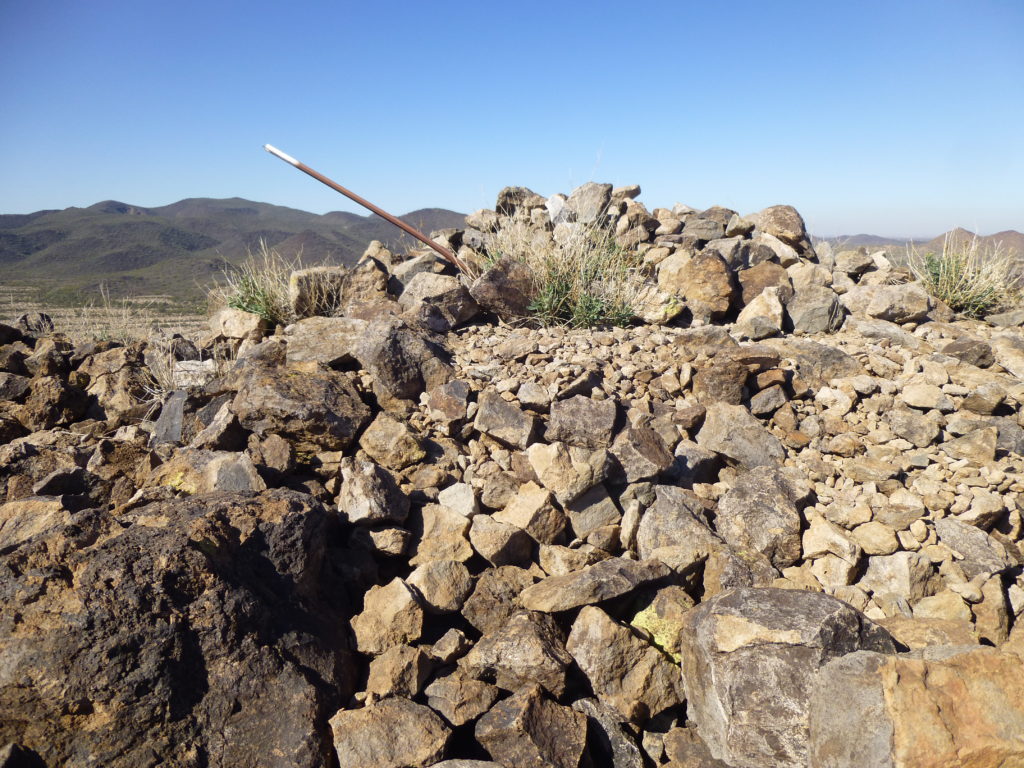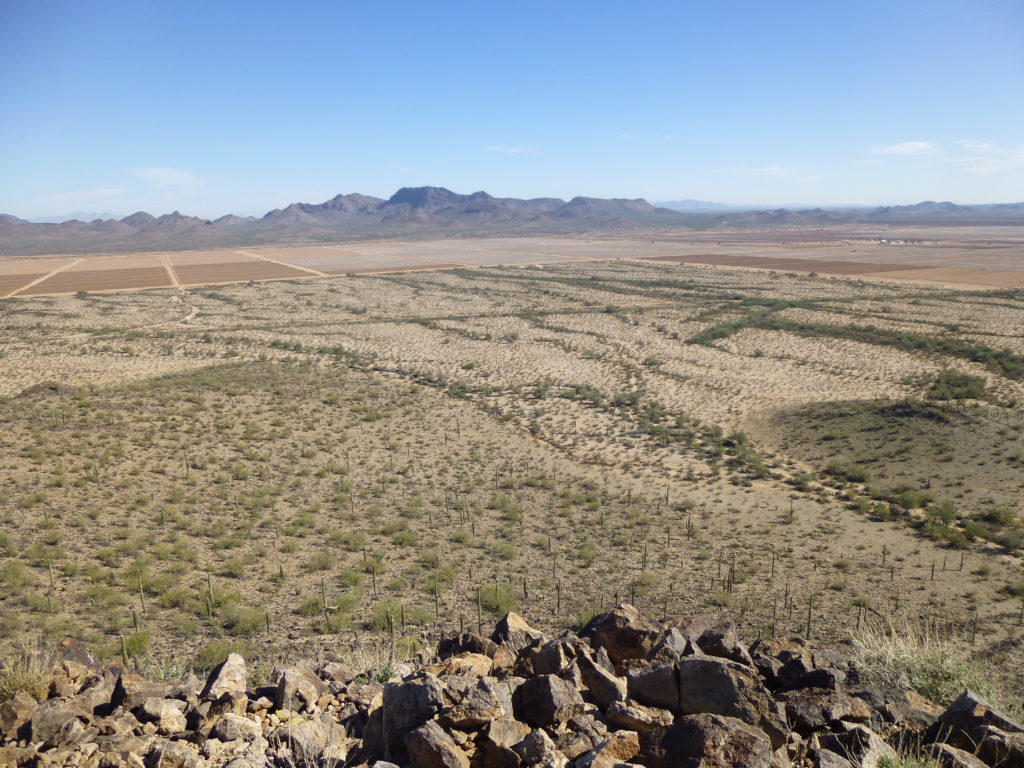The Vaiva Hills – nope, never heard of them, at least not until my climber friend Dave Jurasevich called from out of state and said he was coming to Arizona and would I like to climb there with him? It didn’t take too long to do a little research and find out where they were. In southern Arizona, there is a large Connecticut-sized piece of land known as the Tohono O’odham Indian Reservation, with a scant 11,000 members living within its boundaries. That’s less than 3 people per square mile, so their nation is one sparsely-populated place and large areas are completely unpopulated.
Merely 4 miles south of Interstate 8, a major freeway, can be found the first inklings of the Vaiva Hills. The mountain group no doubt takes its name from the small nearby community of Vaiva Vo (population 136), the name shown on the USGS topographic map.
The village has probably been around for a very long time. This is a shot of only part of their graveyard, and it probably has more residents than the town itself.
The word “vaiva” is the anglicized version of the O’odham word waiwa, which means “cocklebur”; the word “vo” is the anglicized version of the O’odham word wo’o, which means “pond”. So, the village should be named “Cocklebur Pond”, but a sign pointing to the village from the highway simply says “Cocklebur” in English. I thought that cocklebur was some kind of a plant, but I didn’t know more than that until I looked it up.
In any case, in January of 2001, Dave and I met at the Stanfield Road exit on I-8 and convoyed south a few miles into the Vaiva Hills. Our goal was to climb the high point of the mountain group, a peak called Indian Benchmark. Up to this point, the only climbing I’d done on the reservation was to climb its mountain range highpoints, a project finished a dozen years earlier. Dave had suggested we climb the highest points of all the groups labeled “hills” on the topo maps. There were 11 of them, and this was the first we’d try.
After driving west a few miles, we parked near our peak in a quiet valley. I remember, as we walked through a flat area en route to our goal, telling Dave about a recent day my wife and I had spent in an area near Tucson finding ancient potsherds. He thought that was very cool, and expressed how he’d love to do that. Within moments of his saying that, I looked down on the ground and recognized something – a small bit of Indian pottery, no more than half an inch square, but very real. I picked it up and handed it to him. We realized that the people who had populated this region for thousands of years had no doubt left countless signs of their time here, and we had been fortunate enough to have found one of them – we left it where we found it, though. The climb from where we parked was the better part of a thousand feet, a perfect climb on a perfect winter’s day in the desert. Here’s a shot of Indian Benchmark – it’s the huge dark bulk occupying the entire picture in the middle distance – it’s highest point is just right of center. Don’t be distracted by the big peak on the distant horizon to the left of center – that’s a peak called Table Top – more on that one later.
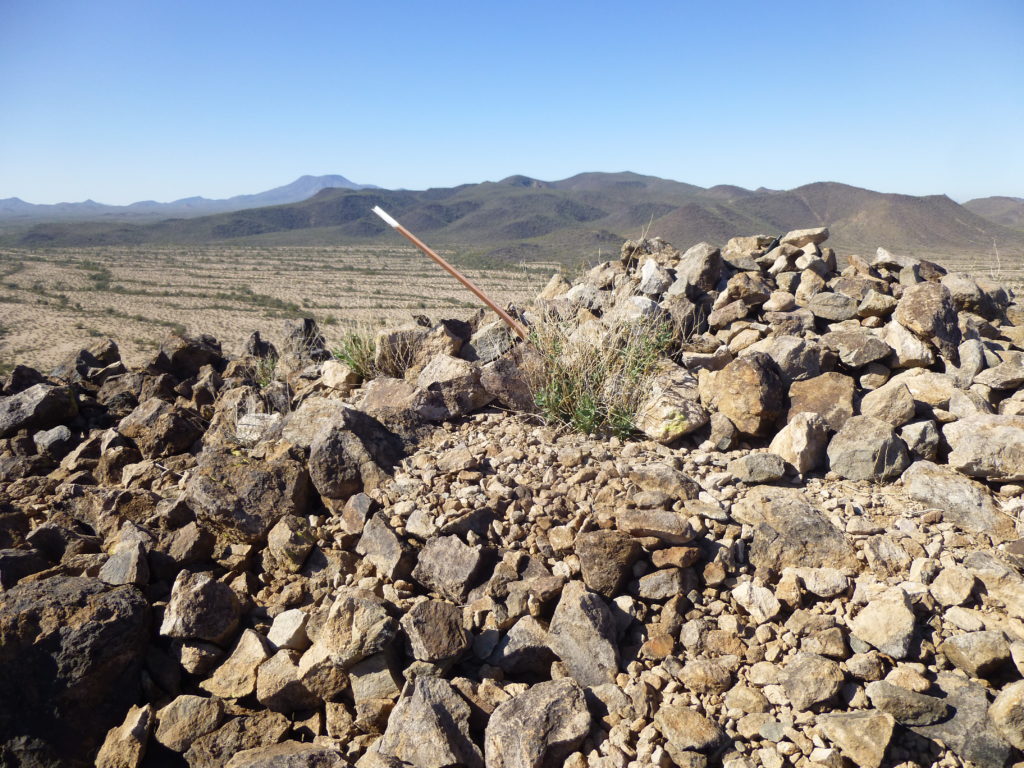
Indian Benchmark – this photo is taken from the summit of another nearby peak less than 3 miles away
Later on that day, though, things went to hell in a hand-basket when my alternator failed as we convoyed to our next peak. That, however, is a tale for another time. This climb was very significant for me because it was the one that kick-started my quest to climb all 401 peaks on the reservation, so I have Dave to thank for that. That day with Dave, in fact the whole 5-day trip with Dave, really got me thinking about climbing on the reservation. I went ahead and got myself a permit to climb out there, and started to make return visits.
As excited as I was to get back to the Vaiva Hills, there were other more urgent peaks to climb – 29 of them, in fact – which delayed me until May 4th of the same year. Early May in that part of Arizona can be a brutal time to climb, and the temperature has reached as high as 102 degrees F on that date. Nevertheless, go back I did, with the intention of bagging as many more of the Vaiva Hills as I could in a day.
The northern peaks were my game on that wonderful day. I parked to the east of Double Peak and walked across the desert floor – I’d make a big loop and climb several. The first one I reached was the east summit of Double Peak, the lower of the double, at 2,161′. I went up the east side, pretty easy, and left a register on the virgin summit.
The other half of the pair was within easy reach, sort of, but as I dropped down the west side to do a traverse of the peak, I realized this sumbitch was a lot steeper than I had anticipated – I found myself making my way very carefully, and had more than one brown-trouser moment on the way down.
It gave me pause, but in a short while I stood in the saddle between the two. The higher western peak stood 2,268 feet, and was a straight shot up its east side – it was steep but without problems. There was no sign of a previous visit there either, so I left a register. Great, so far 2 for 2. Here’s a picture of Double Peak, the western and highest of the pair. It’d be harder to find a more symmetrical peak anywhere.
I dropped down the north side and made the short trek over to my next peak – it was a mere 2 clicks away. Named Needle Peak, at 2,062 feet it was a full 200 feet lower than the one I’d just climbed. When I stepped on to the summit, I was surprised to find no register – was it because it was on the reservation and no one had tried to go there before? Because it was a named peak, and a cool name at that, I was sure some climber had been there before me – no sign, though, so I left a register there too. If you ask me, Needle Peak looked a lot less needle-ish than the western summit of Double Peak.
Needle Peak had its own eastern outlier, a smaller peak with only 200′ of relief – I climbed that one too.
Down its east side, I continued east to one more, something called Bur Benchmark. Hey, after all these years, I just figured out where that name came from – Bur, as in Cocklebur – right? At 1,889′, this was by far the lowest of this whole northern group of the Vaiva Hills. Because it was a benchmark, obviously surveyors had been here before, but once again it looked like I was the first climber to visit. This one inherited the last of the 4 registers I’d carried this morning.
It was less than 2 miles across the desert back to my truck. This had been a very productive outing – in 6 short miles, and with 2,255 vertical feet of climbing, I’d picked up 4 peaks not previously visited by climbers – you can’t beat that return for the effort. I tanked up on cold beverages from my cooler and ate some good food, then headed south on foot for one more.
Peak 1921 sat there all by itself – I went up a little valley on its north side, then up easy slopes to the summit. Same result – no sign of a previous visit, so I left another register. Man, such easy pickings – this one sat only 1 mile from a paved highway!! This was turning out to be one helluva good day.
I went back to my truck and drove east out to the highway, then a mile and a half on pavement to reach a familiar road, the one Dave and I had used a few months earlier to climb Indian Benchmark. A quick 2 miles west on it and I parked at the base of one final peak – a climb of only 450 feet brought me to the summit of Peak 2006.
I clearly remember what happened next. I had taken out my cell phone and called my wife, and even as we spoke I walked into the flight path of some wild bees zipping to and from their hive, a crevice in the rocks near the top. They didn’t like me at all. Sometimes they will fly into you, hitting you as a sort of warning, and one or two did, but then I was stung by two right after that. Man, they can sting you in a split-second when they’ve a mind to. I think that when they sting you, they release a chemical easily detected by their fellows, and that gets more of them riled up. I remember running along the summit ridge in a panic for quite a ways until they left me alone. It’s amazing how something so tiny as a bee can put the fear of God into a human, and even big animals. They got me on my earlobe and my neck, the little shits. I waited a while, laying low, eating and drinking something, then slunk back (I looked this up, honest, and it said the past tense of slink is – take your pick – slunk, slinked and even slank) over to the summit, giving the bees a wide berth. I didn’t stick around, leaving the world’s quickest register, and headed back down to my truck. What a day – 6 peaks and 6 registers. A week later, my earlobe had swelled up and looked like something out of a horror movie.
Less than a year passed. It was bugging me that there were a couple of peaks In the Vaiva Hills that I still hadn’t climbed (a typical reaction of peakbaggers), so one day I went back, this time in March. My records show that I climbed two peaks that day, but honestly, I have zero recollection of them. Only my detailed notes on the field copy of my map reminded me what I did. It appears that I parked once again on the road for Indian Benchmark, then headed south. An easy mile brought me to the top of Peak 2277, a bump on the northern edge of Indian BM. Guess what? – no register. Of course, I left one.
Due east of 2277 was another one, Peak 2037. It was in the shape of a long ridge, with the highest point at its west end. When I reached the top, guess what I found? – nuthin’. Curiouser and curiouser. It was amazing to see how this group of mountains had been avoided by climbers. Sure, I was pleased to have been the first climber to visit them, but I was still baffled by how completely they had been overlooked. Sure, Bob Packard had climbed Indian Benchmark 5 years before Dave and I, but that was the only one that had been visited by climbers before any of these other 8 I had now climbed.
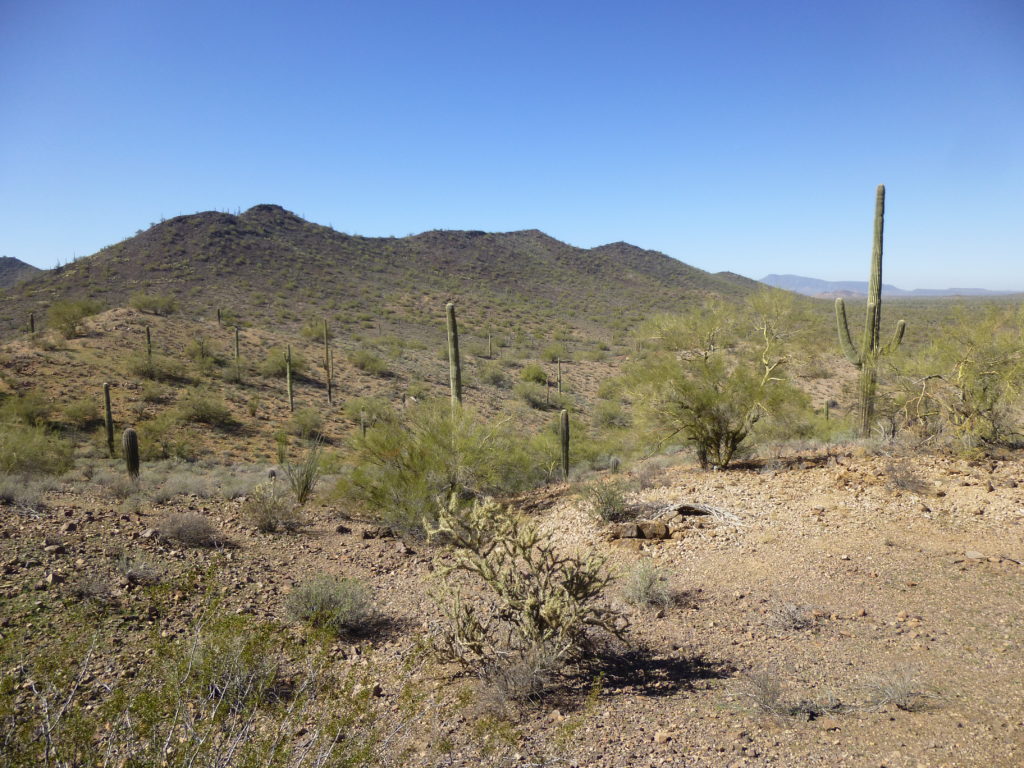
Peak 2037, the northeast side. The entire ridge forms the peak, and its highest point is way down at the right-hand end
So, here it was 2002 and I was done with the Vaiva Hills. Or was I?
Fast-forward to 2017. Having now climbed most things in those parts, I started to think of excuses to re-visit some of my favorite areas. A closer examination of the Vaiva Hills brought to light a few other peaks, ones that would interpolate to the 300-foot threshold commonly used in the U.S. to define a peak. Lo and behold, I found 3 more peaks to climb, albeit small ones.
February found me driving along a quiet dirt road out to the farthest western reaches of the mountain group. Parking as close as I could, I headed northwest on foot and crossed two miles of flat desert, putting me in short order on top of Peak 2223.
You couldn’t get much closer to the reservation boundary – this summit sits a scant 450 feet from it. Once again, there was no sign of any previous visit. Less than 5 miles away, on the northwestern horizon, sat Table Top, a huge peak which completely dominated the entire area – it was the elephant in the room, hard to take your eyes off of it. Here, you see the unbroken sweep of desert right over to it.
The last stragglers of the Vaiva Hills lead up to this point, but not beyond.
The entire range covers an area only 6 miles across, no matter how you measure it, and it all ends here. I spent a while on top, then sauntered down the slope and made my way back to my truck.
It didn’t take long to drive the couple of miles to my next peak. This area has quite a few earthen check dams, like this one, which catch runoff and impound it for animals to drink.
I parked near here and had my goal in plain sight – an easy mile’s walk across flat, open desert was all that was needed. However, just a few hundred yards from my truck I came across this old bicycle, rotting away out in the open. I looked it up on the internet, and discovered the bike was new in 1993, and at that time sold for $339.00 US. I find old bikes abandoned in the desert quite often – pretty much without exception, they are used by Bad Guys while committing crimes – it certainly wasn’t the Native American population riding around.
As I approached Peak 1900, there were signs of illegal activity in the area – discarded water jugs, food cans, the odd backpack. This was obviously a route heavily used by lawbreakers. So many boots had trodden the low pass that an obvious path had been worn.
I’m always wary in such a place, on the lookout for Bad Guys lurking nearby – they’ll often lay low during daylight, then move under cover of darkness to avoid the prying eyes of law enforcement. They don’t take into account the infrared capabilities of the Border Patrol with drones, light aircraft and helicopters, though, and that’s often their undoing. It was a quick scramble to the top. Yes, I left a register, but it would soon enough disappear when the next criminals go to the summit to scan the countryside.
Back at the truck, I drove out to the highway, south about 8 miles and then around to the quiet back side of one more peak. Remember I said earlier that my research had found 3 more peaks in the Vaiva Hills, all of them interpolated? Well, this was the last one of the 3, and the 12th and final one in the range – Peak 1860.
There was a simple rock wall built on the summit, and a bent T-stake.
A few miles to the east could be seen large tracts of irrigated land on the reservation.
Back down at the truck, I realized that my rambling in the Vaiva Hills was done and over with. It had been a full 16 years in the doing, and every bit of it had been enjoyable. There wasn’t anything left to climb, and I’m not likely to repeat any of them. No worries, there are plenty of other ranges to scour. Thanks for taking this journey with me.

